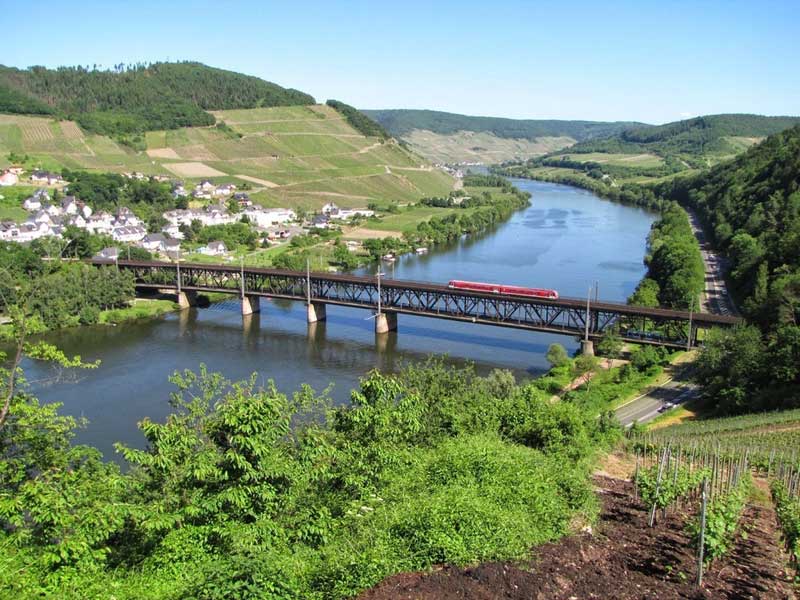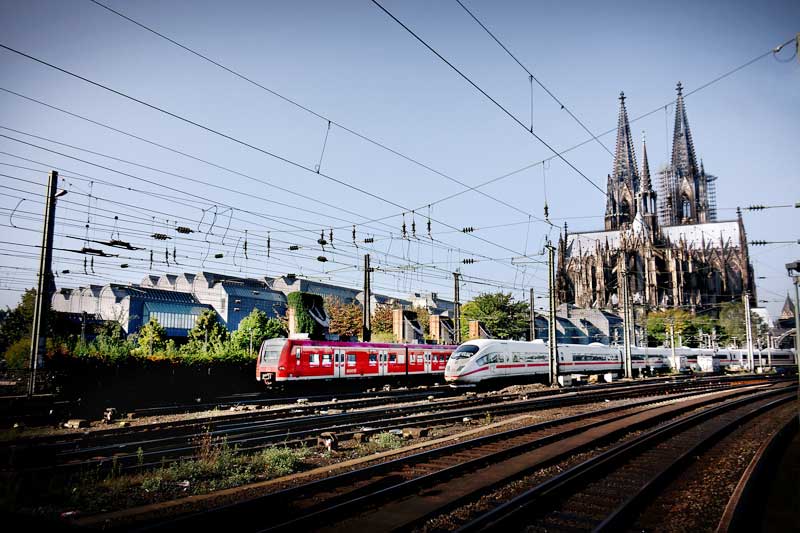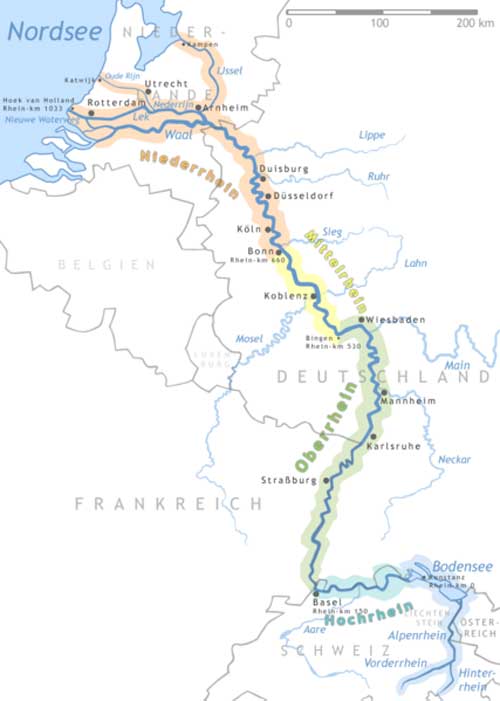Rhine Valley By Rail

The stretch of the Rhine River which meanders in wide flat current between the steep hillsides of the Rhineland came to the world's attention in the 1800s when Lord Byron described the haunting wrecks of castle ruins clinging above the river around twist and switch of the river in the 3rd Canto of his epic travelogue "Childe Harold". Even farther back the German medieval roving poets sang the Song of the Lorelei, the "Lorelei Lied", of the long golden haired maiden who would sing exquisitely from the shore, luring the sailors on the mighty river to crash on the rocks where the shallows make the hard turn around the rocky prominence name for the legend (see Lorelei Rock).
The Middle Rhine between Bingen and Koblenz is now designated as a UNESCO World Heritage site for its castle dotted slopes. Today, freight ships and tankers as well as passenger cruise ships of wide-eyed tourists motor up and down the river day and night. Many of the castles, once ruins have been turned into touring destinations and even hotels.
The Rhine Valley offers romantic German landscapes straight from a fairytale - castles rising above swirling waters, past the narrows where the siren Loreley sings sailors onto the rocks. A variety of trains types - from the sleek modern ICE (Inter City Express) trains to modest local services - use the main Rhine Valley routes. Beautiful riverside routes make this the ultimate rail-cruise. The most celebrated part of the scenic Rhine Valley route is the 60-km stretch south from Koblenz. It takes 30 mins on the fastest trains or up to an hour on local services.
Savvy travellers heading south from Cologne opt for the classic line which hugs the Rhine through its famous gorge section upstream from Koblenz past the Loreley towards Rudesheim and Bingen. Be aware that there is also a new line which is used by fast trains from Cologne to Frankfurt that by-passes these scenic highlights of the Rhine Valley.
Comfortable ICE and EuroCity services allow for a sedate cruise with large windows for sightseeing and few en-route stops. Opt for slower local trains if you wish to stop off here and there along the way.
Good places to stop and have a look around include Rudesheim, Kaub (castle in the river) and Braubach (Burg Marksburg, best castle in the area). Marksburg offers a good castle tour. If you have luggage, only large stations such as Koblenz have lockers.
The Middle Rhine Valley By Rail
The part of the river called the Middle Rhine is the most famous. The most common starting points for a tour of the Rhine Valley are Cologne, just north of Bonn, and Frankfurt, just east of Rudesheim. Frankfurt is actually on the Main, not the Rhine itself, so the Rhine towns of Mainz and Wiesbaden also make popular starting points.
Trains run along either side the Rhine River between Mainz and Koblenz. The scenic Linke Rheinstrecke ("Left Rhine Line") runs along the left (west) bank of the river from Cologne to Mainz, while the Rechte Rheinstrecke ("Right Rhine Line") runs along the right (east) bank of the river from Cologne to Wiesbaden. The Linke side, generally considered the more scenic of the two, is more heavily trafficked and has InterCity services, while the Rechte side is mostly dedicated to cargo and is limited to regional passenger trains running less than once per hour. Interchanging between the two is possible at Koblenz; the city is on the left, but some trains running on the Rechte start or terminate in there.

Cologne
The InterCity and Eurocity trains make few stops along this scenic section of the river, at Boppard (see Boppard Rhine) and St Goar. If you want to stop and stay in one of the other Rhine river towns, or just get a little slower view, the MittelrheinBahn train (MRB) is a local service train which stops at all the small villages where one can explore the castles. Don't miss ascending the Loreley bluff in St Goarshausen. Distance & time: 61km, 50 minutes.
For an even slower view, you could take a river cruise boat trip from Mainz or Bingen to Koblenz. KD Cruises between Mainz and Cologne on the Rhine and Koblenz and Cochem on the Mosel are free with a Rail Pass.
Travelling north, after Koblenz and Bonn, the Rhine River shore gets a little industrial as it travels through Germany's very developed and most densely populated areas. Here your journey offers some choices. With Benelux added to the pass you could head over to Luxembourg, up through the Belgian Ardennes into the Netherlands to Amsterdam or Rotterdam. If sticking with Germany, from Cologne with its famous great cathedral and lively bar scene, you have a few choices, head over to Aachen and the Mosel River (see Reichsburg Castle Cochem), continue along the Rhine on the IC 2114 to Dusseldorf (see Dusseldorf on the Rhine) or take the IC 2024 to Bremen and Hamburg.
Destinations
Cologne
This lively city on the Rhine offers a wealth of cultural activities, international trade fairs and conferences, and numerous major events. Attractions such as Cologne Cathedral, which is recognized as a UNESCO World Heritage Site, and the city's 12 large Romanesque churches create an unforgettable impression on visitors. What's more, the cathedral city of Cologne is home to many museums and galleries that present top-class art treasures of all styles and from all epochs.
Bonn
There are few cities in recent history that have to live with the label of 'ex-capital city', but Bonn is one of them. Nevertheless, those who thought Bonn would fade into obscurity without its capital status have been proven wrong. Previously known as the 'federal village', and now an internationally renowned hub of commerce and culture, Bonn comes across as assured and cosmopolitan as ever.
Koblenz
At the famous Deutsches Eck, or German Corner, where the Rhine and Moselle converge, lies one of Germany's oldest and most beautiful towns - Koblenz. Vineyards, forests and four mountain ranges form the backdrop to the city, whose 2,000-year history has given rise to beautiful churches and castles, palatial residences and grand town houses.
Boppard
Boppard, in the Rhein-Hunsruck-Kreis (district), lies in the Rhine Gorge, a UNESCO World Heritage Site. The town is a state-recognized tourism resort and is a winegrowing centre. Directly north of Boppard, the Rhine takes its greatest bend - the Bopparder Hamm - although this name is more commonly applied to the winegrowing area found along it. The best known lookout point over this bow in the Rhine is the Vierseenblick, which can be reached by chairlift. The Vierseenblick mentioned above offers a rather obscured view of the Rhine, however, the Gedeonsec affords an outstanding view of the great bow in the Rhine.
St. Goarshausen
St. Goarshausen is a town located on the eastern shore of the Rhine, in the section known as the Rhine Gorge, directly across the river from Sankt Goar. Close to the town in the hillside just above it, lie the ruins of 14th century Castle Katz, ruined since 1806. The most famous point in town, that also brings the most tourists is the site of the Lorelei rock. In St. Goarshausen there are two castles, Burg Katz (English: Castle Cat) and Burg Maus (English: Castle Mouse). Burg Katz is not open for visitors. There is a good view over the town from Burg Maus, and also visible are the ruins of Burg Rheinfels on the other side of Rhine.
Kaub
Kaub, original home of the wine growers, pilots and slate-miners is well-known because of its Toll Station Pfalzgrafenstein, commonly referred to as the Castle in the River. Located above Kaub, the castle Gutenfels got its name during the Bavarian-Palatine war of succession, after the city and the castle withstood a 39-days siege. A trip by ferry to the never destroyed castle on the Rhine isle is quite an experience. Here one can enter the world of toll collectors and traders from past centuries.
Bacharach
In the Valley of the Lorelei rock between Mainz and Kaub, Bacharach. The original name Baccaracus points to Celtic beginnings. Above the town looms Stahleck Castle (Burg Stahleck), which was already inhabited in the year 1095. It is a youth hostel today. Bacharach thrives on tourism and wine from Bacharach is still enjoying international popularity. Running regularly to and from Bacharach are the excursion ships of the Koln-Dusseldorfer-Rheinschiffahrt, or KD for short.
Bingen
Located at the junction of the Rhine and the Nahe, Bingen came into being as a strategically important to the Romans. For bike riders, Bingen is the starting point of the Radweg Nahe, a 37 mile posted bike route that follows the Nahe River southwest to the town of Kirn. Bingen is also the site of an eleven-day festival every September, when the city hosts the Winzerfest. It was the birthplace of Saint Hildegard von Bingen, an important polymath, abbess, mystic and musician, one of the most influential medieval composers and one of the earliest Western composers whose music is widely preserved and performed.
Rűdesheim am Rhein
Rűdesheim am Rhein is a town known for winemaking, especially of Riesling wines. In the centre, Drosselgasse is a lane lined with shops, taverns and restaurants. Nearby, Siegfried's Mechanical Music Cabinet is a museum of automated musical instruments. Medieval Bromserburg Castle is home to the Rheingau Wine Museum, exhibiting wine paraphernalia from ancient times to the present.
Mainz
Mainz known for its old town, with half-timbered houses and medieval market squares. A distinctive octagonal tower tops the Romanesque Mainz Cathedral, built of deep red sandstone. One of the several museums of Mainz, the Gutenberg Museum honors the inventor of the printing press with exhibits, including two of his original bibles. Its rich cultural heritage incorporates a well-established winegrowing tradition, which only adds to Mainz's appeal.
Mannheim
Mannheim, at the confluence of the Rhine and Neckar rivers, is the second biggest city in Germany's Baden-Wurttemberg. It is one of the hotspots of immigration. Because of that you'll encounter a lively and colorful mixture of nationalities and cultures in the city. The Mannheim/Heidelberg area hosts the largest concentration of US military personnel in Germany, and barracks are found in many of the suburbs. The centre of Mannheim is laid out like a chess board, with no real street names.
Basel
One of Switzerland's underrated tourist destinations, Basel is a city on the Rhine River close to Switzerland's borders with France and Germany. Its medieval old town centres around Marktplatz, dominated by the 16th-century, red-sandstone Town Hall. Its 12th-century Gothic cathedral has city views, and contains the tomb of the 16th-century Dutch scholar, Erasmus. The city's university houses some of Erasmus' works.
About the Rhine River
The Rhine River begins in the Alps of Graubunden in southeast Switzerland, where it is a swift flowing roil of ice green rapids, sometimes called the Baby Rhine, then flows north past Liechtenstein to Lake Constance (the Bodensee), then between the German Black Forest and Switzerland, over the Rhine falls at Schaffhausen to Basel, where it turns north, flattening to the wide familiar great river between Germany and France's Alsace, past Mannheim and Mainz to Koblenz (called the Middle Rhine), to Cologne and Dusseldorf and out to the north sea in the Netherlands. The largest city on the river Rhine is Cologne, Germany, with a population of more than 1,050,000 people. It is the second-longest river in Central and Western Europe (after the Danube), at about 1,230 km.



